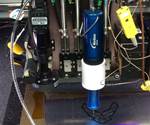U.S. and Japanese scientists partner on composite simulation study
Scientists from the U.S. Air Force Research Laboratory and the Japanese Ministry of Defense will use simulation software to study impact effects on composites used in figher aircraft.
As part of a scientist exchange program, Dr. Keisuke Umezawa from the Japanese Ministry of Defense (JMoD; Tokyo, Japan) has recently joined the Air Force Research Laboratory (AFRL; Dayton, Ohio, U.S.) to work on a joint research project involving prototype composite structures.
Umezawa’s primary focus for the exchange program will be the modeling of damage evolution in polymer matrix composite (PMC) materials using an AFRL-developed research software package known as BSAM. The software is a result of years of research and development led by Dr. David Mollenhauer of AFRL’s Composite Performance Research Team.
The stress analysis software simulates damage processes in composite materials, which is characterized by complex networks of cracking in the polymer matrix, delamination between layers and fiber fractures.
Umezawa is training on the software and then developing a variety of PMC damage simulations. His primary simulation campaign will focus on simulations of laminated PMCs that have a long, thin saw-cut, mimicking a crack, and observe how damage grows from these “cracks” within the BSAM simulation environment.
Umezawa was chosen by JMoD for his research experience as a stress analysist of polymer matrix composite materials (PMC), including the development of a test program for prototype PMC structures for next-generation Japanese fighter aircraft. “I’m happy to work as an ESEP engineer in AFRL and very excited to join the project on BSAM,” says Umezawa.
“I’m elated to work with Dr. Umezawa to further enhance the strong relationship between the U.S. Air Force and the JMoD’s Air Systems Research Center,” says Mollenhauer.
Hands-on use of AFRL products by colleagues benefits the U.S. Air Force by providing feedback on usability, capability and needs. Umezawa will aid in the evaluation of the simulations against experimental results gathered at AFRL, resulting in a better understanding of the BSAM code’s effectiveness.
Related Content
-
Industrializing additive manufacturing in the defense/aerospace sector
GA-ASI demonstrates a path forward for the use of additive technologies for composite tooling, flight-qualified parts.
-
MATECH C/ZrOC composite is deployed in hypersonic aeroshells
Ultra high-temperature insulating CMC targets hypersonics, space heat shields and other demanding applications, tested up to 2760°C under extreme stagnation pressures.
-
The AAMMC Tech Hub: Ramping U.S. production of large thermoplastic composite aerostructures
CW talks with Syensqo, Spirit AeroSystems and other consortia members about current funding, specification of the next world’s largest press, organizational structure and projects to support U.S. companies in the race to deliver >40,000 sustainable and efficient aircraft over the next 20 years.
.jpg;width=70;height=70;mode=crop)





